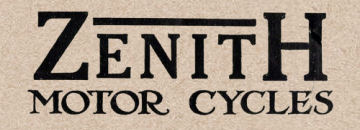



The 1921 Zenith, to which several detail improvements have been made. (This is believed to be a 5hp Zenith - it differs to the new 8hp model shown at Olympia in that it lacks a front brake. mxn)
Many Refinements on Standard Models; a New Flat Twin to be Exhibited.
IN the new models of the Zenith for 1921, the chief alterations are in the nature of detail improvements which have been found desirable in practice.
Particular attention has been paid to mudguarding. The front mudguard extension, instead of following the curve of the wheel, now slopes up slightly, with the result that the liquid mud has a chance to run to the rear. A further improvement is the addition of a mudflap, underneath which the front stand is fastened. With this improved mudguard there is now no necessity for the shield, which serves to protect the belt and clutch casing on former models Moreover, this and the crank case are not shielded from a cooling current of air. The side valances to the rear mudguard are now provided with a trough, which prevents mud and wet from dropping directly on to the belt rim. One of the new features will be a front brake acting on a dummy belt rim, and this is both smooth and powerful in action.
So far as the transmission is concerned, the chain to the countershaft is now entirely enclosed in a handsome aluminium casing, the top half of which may be removed after undoing three bolts. This casing has done much to silence the chain, which, after a personal trial, we found to be quite inaudible. Some considerable improvement has also been effected in the method of working the clutch, which, is now released by means of an exceedingly long pedal; with the latter is incorporated an ingenious pawl allowing the clutch to be held out of engagement when the machine is brought to a standstill.
An 8 h.p. Sports model will be made, and it is equipped, like the machine we have just described, with 28x3in. tyres and the latest pattern mudguards, but it is without a clutch.
The 2¾ h.p. flat twin and the 5 h.p. models will remain practically unaltered, while the new Bradshaw-engined model with its horizontally-opposed power unit, which is described elsewhere in this issue, will be one of the Show's attractions.
The Motor Cycle November 25th, 1920. Page 649

A sporting model Zenith fitted with the Bradshaw flat twin engine is one of the real novelties of the Show. Note the unusual crank-case construction.

Delicate clutch manipulation is made possible on the Zenith by means of an exceptionally long pedal.
Troughs to carry water to the rear are provided on the Zenith back mudguard (shown detached)
The 1920 Olympia Show.
ZENITH. (Stand 87.)
3½ h.p. Bradshaw; 68x68 mm. (499 c.c); horizontal twin-cylinder four-stroke; overhead valves; mechanical lubrication; B. and B. carburetter; gear-driven magneto; Zenith-Gradua gear; belt drive; Avon 26x2-¼ in. tyres. Price (provisional) £130.
Zenith Motors, Ltd., Hampton Court.
Probably the greatest attraction on the Zenith stand is the new Bradshaw engine sporting machine. The engine of this may be regarded as the first attempt at really scientific oil-cooling. As has already been described in The Motor Cycle, the cylinders are sunk inside the crank case, only the heads being exposed. The forced-feed lubrication pump provides a constant stream of oil from a separate tank in which it is kept cool, and the cylinders and pistons are cooled as well as lubricated by this oil, which is then returned by a second pump from the crank case into the oil tank. The preliminary tests of the model (which will not be in production until February) show it to be possessed of a very good turn of speed as well as pulling power, and it will certainly become immensely popular with those who prefer a sporting solo machine of high performance.
2¾ h.p.; 58¼ x 65 mm. (346 c.c); two-cylinder flat twin four-stroke; side-by-side valves; hand pump lubrication; Amac carburetter; gear-driven magneto; Zenith Gradua gear; chain and belt drive; 26in. x 2¼ in. tyres. Price £107.
This light sporting model remains practically as it was, it having been found so fully up to its work that no alteration is needed. It is a fascinating solo mount, and makes a great appeal to those who find that 350 c.c. gives them the performance they require.
5 h.p.; 70x85 mm. (654 c.c); cylinder V twin four-stroke; side-by-side valves; hand pump lubrication; Amac carburetter; chain-driven magneto; Zenith Gradua gear; belt drive; 650x65mm. tyres. Price £123.
This model, also the heavier sporting models "E" with 6 h.p., and "G" with 8 h.p., engines (both of which are priced at £139), resemble the 2¾ h.p. flat twin, in being practically unaltered; they are too well-known to need further description. It should be added, however, that improvements have been embodied in details, particularly in the direction of mudguarding. The 8 h.p. clutch model with countershaft, which is priced at £162, has a new and excellently arranged clutch pedal of very long leverage, with a ratchet pawl to hold the clutch out it desired.
The Motor Cycle, December 2nd, 1920.